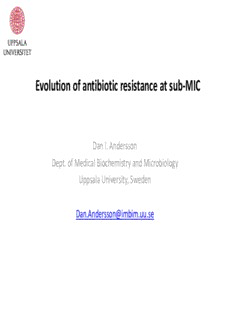
Evolution of antibiotic resistance: Selection of resistance at non-lethal (sub-MIC) PDF
Preview Evolution of antibiotic resistance: Selection of resistance at non-lethal (sub-MIC)
Evolution of antibiotic resistance at sub-MIC Dan I. Andersson Dept. of Medical Biochemistry and Microbiology Uppsala University, Sweden [email protected] Two main points 1. Extremely low antibiotic concentrations can drive fast evolution towards high-level resistance clinically important resistance development probably occurs in the environment this type of evolution is probably largely underestimated because of how we do genetics 2. Weak selection generates more problematic resistant mutants Studies of resistance selection at very low antibiotic concentrations require: 1. Whole genome sequencing 2. Genetic reconstruction (e.g. Lambda red recombineering) 3. Very sensitive competition experiments Selection of resistance ”Mutational space” (mutations and HGT) Susceptible ”wild type” Each circle represents one specificresistant mutant Size= Rate of formation Mutant fitness How will the selective pressure affect which resistant mutants emerge? Resistance level Defining selective pressure Most of our understanding of resistance evolution comes from using lethal selections ”Unconstrained” ”Mildly constrained” ”No growth” growth growth (lethal selection) e t a D= selective r e pressure v i t c u d o r D= selective p e R pressure Drugs for human treatment and veterinary use are released into the environment Of the >500,000 tons of antibiotics used per year globally ≈50% is released in active form into the environment, mainly via human and animal urine Antibiotics are mainly excreted in urine % of dose excreted from humans in active form Fluoroquinolones 40% Aminoglycosides 80-90% Tetracycline 40% Macrolides 20-30% B-lactams 50%-90% Trimetoprim 50% Selective pressures of varying strength in humans, animals and environment About 1/3 About 2/3 Bacteria Antibiotics Human medicine Animal Plant Therapeutic use husbandry production Bothstrong (ug/ml) ANDweak(<<ug/ml) selectivepressures Therapeutic use Aquaculture Community Hospital Preventive use Fish, shrimp 90% 10% Food Growth promotion farming Directspread/ Urine(feces) Urine runoff (feces) Waste water/sludge Manure Weakselective pressures (ng-pg/ml) Lakes, rivers, soils Environment Key question: What are the lowest concentrations of antibiotics that are selective? MIC= Minimal Inhibitory Concentration MSC= Minimal Selective Concentration Weaker selection Stronger selection Resistant Susceptible PLoS Pathogens 2011 Key question: What are the lowest concentrations of antibiotics that are selective? Mix susceptible (S) and resistant (R) bacteria and let them compete at different antibiotic concentrations o i t a r S : R What is this concentration? 1/Antibiotic concentration Determining the minimal selective concentration Approach: Compete resistant and susceptible bacteria at different antibiotic concentrations to determine the lowest concentration at which resistant bacteria will be selected Take-over by adaptive Problem: Periodic selection mutation unrelated to will always limit sensitivity of competition set-up competition assays Solutions: 1. Label cells with YFP/CFP and count with flow cytometer --> higher sensitivity 2. Pre-adapt strains--> decreases likelihood of adaptive mutations Can detect Ds differences as small as 0.001 (0.1%)
Description: